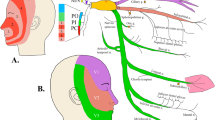Abstract
In this article, the anatomic and physiologic characteristics and clinical syndromes involving the auriculotemporal nerve (ATN) are reviewed. The ATN is a terminal branch of the mandibular nerve (third division of the trigeminal nerve). The syndrome of ATN neuralgia (ATNa), which is characterized by attacks of paroxysmal, moderate to severe pain on the preauricular area, often spreading to the ipsilateral temple, is discussed in this article. The classification of ATNa under the Second Edition of the International Classification of Headache Disorders, as well as our personal experience in diagnosing and treating this syndrome, also are reviewed.
Similar content being viewed by others
References and Recommended Reading
Headache Classification Subcommittee of the International Headache Society: The International Classification of Headaches Disorders, edn 2. Cephalalgia 2004, 24(suppl 1):1–150. This seminal paper presents the classification of headaches that is endorsed by the International Headache Society.
Gordon L, Ritland GD: Nerve entrapment syndromes. Conn Med 1974, 38:97–102.
Loughner BA, Larkin LH, Mahan PE: Nerve entrapment in the lateral pterygoid muscle. Oral Surg Oral Med Oral Pathol 1990, 69:299–306.
Schmidt BL, Pogrel MA, Necoechea M, Kearns G: The distribution of the auriculotemporal nerve around the temporomandibular joint. Oral Surg Oral Med Oral Pathol Oral Radiol Endod 1998, 86:165–168.
Ide I, Nakazawa K: Anatomical Atlas of the Temporomandibular Joint. Tokyo: Quintessence Publishing Company; 1991.
Anil A, Peker T, Turgut HB, et al.: Variations in the anatomy of the inferior alveolar nerve. Br J Oral Maxillofac Surg 2003, 41:236–239.
Benedittis G: Auriculotemporal syndrome (Frey`s Syndrome) presenting as tic doloureux. J Neurosurg 1990, 72:955–958.
Frey L: Le syndrome du nerf auriculo-temporal. Rev Neurol (Paris) 1923, 2:97–104.
Fernandes PR, Vasconsellos HA, Okeson JP, et al.: The anatomical relationship between the position of the auriculotemporal nerve and mandibular condyle. Cranio 2003, 21:165–171. A recent anatomic study that revealed a significant variation in the relationship of the ATN to the middle meningeal artery. This study also presented the relationship between the ATN and the head of the mandible.
Damarjian E: Auriculo-temporal neuralgia: an original diagnostic and therapeutic approach. R I Med J 1970, 53:100–101.
Pareja JA, Pareja J, Yangüela J: Nummular headache, trochleitis, supraorbital neuralgia, and other epicranial headaches and neuralgias: the epicranias. J Headache Pain 2003, 4:125–131. This article describes some headaches and neuralgias that have temporal or spatial features suggesting a peripheral (extracranial) origin, which the authors called epicranias. Epicranias essentially differ from other primary headaches because of their intracranial origin and features of visceral pain.
Author information
Authors and Affiliations
Rights and permissions
About this article
Cite this article
Speciali, J.G., Gonçalves, D.A.G. Auriculotemporal neuralgia. Current Science Inc 9, 277–280 (2005). https://doi.org/10.1007/s11916-005-0037-0
Issue Date:
DOI: https://doi.org/10.1007/s11916-005-0037-0




